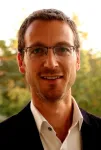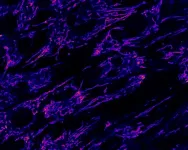(Press-News.org) By Alistair Jones
SMU Office of Research – Even by the standards of medical terminology, photoplethysmography (PPG) is a mouthful. Yet it is widely used in clinical settings as a non-invasive, optical technique for measuring the oxygen saturation level in the blood, and the pulse rate, as vital signs of a patient. It is commonly encountered as a clip-on oximeter attached to a finger.
First developed in the 1930s, PPG emits light to illuminate the microvascular bed of the skin. Then a photodiode, positioned alongside the light emitter, captures the reflected light, termed the PPG waveform, which provides insights into the cardiovascular system. Since the 1980s, oximeters have been a standard component in the US for patient monitoring during anaesthesia.
With the 2010s came the rise of consumer health wearables, such as the smartwatches and fitness trackers that are now used by millions of people. PPG is incorporated into these devices but environmental factors limit the range of accurate information they can provide, compared with PPG used in stationary settings.
Finding the means to unleash the potential of PPG for wearable healthcare is the focus of new research headed by Dong Ma, an assistant professor in the School of Computing and Information Systems at Singapore Management University (SMU). The project has been awarded a Ministry of Education (MOE) Academic Research Fund (AcRF) Tier 2 grant.
"I aim to enhance the accuracy and reliability of PPG-based monitoring of human vital signs and unlock new capabilities for human cardiovascular monitoring in real-world scenarios, using wearable devices," Professor Ma says.
Significant challenges
"The world is facing the grand challenge of an increasingly ageing population. Increasing people’s awareness of health management and developing wearable technology to monitor health status in daily life, especially for the elderly, plays a vital role in this campaign," Professor Ma says.
But the full realisation of PPG's potential in practical wearable settings encounters two significant challenges. The first of these is motion artefacts.
"Any factor that affects the propagation path of light will distort the PPG signal and affect the sensing performance," Professor Ma says.
"Motion artefacts, such as different active movements of the user, can cause displacement between the PPG sensor and human skin. As a result, the transmitted light and received light may not align well with the blood pulses, introducing noise to the recorded PPG signal."
The second impediment to gaining accurate PPG readings with wearables is posture.
"When human posture changes during wearing a smartwatch, the contact pressure (tightness) between sensor and skin also changes, resulting in the deformation of skin and the quality of the PPG signal," Professor Ma says.
Given that wearable devices are meant to be used in active scenarios, and that they have been incorporating PPG since the 2010s, it begs the question of why it has taken so long for research such as Professor Ma's to eventuate. He points out that, in fact, improving the quality of PPG signals has always been an active research topic during the past decades.
"But the [proposed] solutions evolve from pure signal processing to more advanced learning-based approaches," Professor Ma says.
"In my opinion, there are two key reasons why improving a distorted PPG signal is challenging: first, the intended signal (blood pulses) is much weaker than external motion artefacts; and second, when there is a displacement (such as sensor detached from the skin), the intended blood pulses are completely absent in the measured signal, making restoration extremely challenging."
Pressure sensors
The novel solution proposed by Professor Ma and his co-researchers is to incorporate the contact pressure (CP) of the device against the skin into the calculations.
"Currently, there is very little research exploring the impact of CP on the PPG signal. And all of them just demonstrate CP can affect the waveform pattern of the PPG signal, but do not propose any solution to address the issue. My proposal aims to integrate CP as a main factor," Professor Ma says.
"Since the proposal submission, we have started working on the project and have successfully developed an effective transformation model that can reconstruct CP-distorted PPG waveforms. That paper is currently under review."
But a move into the real world will require the fabrication of transparent pressure sensors that do not impede the light flows of PPG.
"Based on initial exploration, currently there are no commercially available transparent pressure sensors. But during my interaction with researchers from material science, [I have found] it is technically possible to manufacture such pressure sensors," Professor Ma says.
"And of course, my proposal can promote their development, as material researchers are always looking for a good application for their development. I am seeking collaboration with these researchers to build the sensor."
Real-world monitoring
"Current PPG-based wearable devices are good at measuring HR (heart rate) and SpO2 (oxygen saturation level) in both stationary and motion cases," Professor Ma says.
"They also support the measurement of HRV (heart rate variability) and BP (blood pressure) but are constrained in stationary cases with a proper setting to obtain a good performance.
"The performance degrades in active scenarios as they require more fine-grained and sophisticated features. Other applications, such as breathing rate estimation, vascular ageing, atherosclerosis and blood glucose estimation have been demonstrated with PPG in [stationary] research, but are still challenging to deploy on wearable devices for real-world monitoring.”
Professor Ma's research is particularly pertinent to Singapore.
"First, Singapore is one of the countries that is considered super-aged in the near future. Wearable healthcare technology is an effective weapon in elderly care, promoting an active lifestyle and fostering overall wellbeing," he says.
"Second, cardiovascular disease accounted for 31.4 percent of all Singaporean deaths in 2022, and more than 400,000 Singaporeans are living with diabetes. These diseases require continuous and daily monitoring of the health status, whereby PPG-based wearable technology can help."
Professor Ma has become an expert in wearable sensing. So, how did this come about?
"Many of my previous research projects have focused on human behaviour sensing, but I found physiological sensing has more significance as it reflects how internally the human body is functioning. And I believe with the increased awareness of health management and global ageing, there are more needs and challenges that can be explored in the future," he says.
END
Improving the scope of wearable monitors
2025-02-28
ELSE PRESS RELEASES FROM THIS DATE:
Zeroing in: SMU project to boost indoor localization capabilities for the public agencies
2025-02-28
By Vince Chong
SMU Office of Research – With the surfeit of trackable, wearable devices in modern life, there is little problem locating things and people outdoors by leveraging Global Navigation Satellite System (GNSS) solutions (GPS is an example of this type of solution) that use signals from satellites. Indoors on the other hand, is a different matter as GNSS signals are unavailable and other possible signals such as those from Wi-Fi systems are inconsistent, and often distorted.
And when this ability to swiftly, accurately locate indoor objects is starkly crucial to essential services that make the difference between life and death, upgrading ...
E. coli strain in Egyptian dairy products also found in Japan school outbreak
2025-02-28
No one should have to fear food poisoning every time they eat or drink, but the reality, even in the 21st century, is that risks remain. An Osaka Metropolitan University-led Egypt-Japan research team found E. coli prevalent in over 25% of popular milk and dairy products in Egypt.
Of the 210 samples of raw milk, cheese, and yoghurt, 26.2% were positive for E. coli, with the highest being raw buffalo milk at 68%, and the lowest at 7.5% for rayeb, a type of fermented milk. The preference for raw milk instead of pasteurized milk and varying hygienic conditions at small dairies and markets could explain these results. Yet food poisoning ...
Quantum computing “a marathon, not a sprint”
2025-02-28
By Christie Loh
SMU Office of Research – When his parents heard that he had won an award at his workplace, they were naturally delighted, showering their son with a confetti of questions like what the prize was for, whether there was a formal ceremony, and that he must keep up the good work. Indeed, Monit Sharma is well aware that as encouraging as the SMU Research Staff Excellence Award is, the professional road he is on calls for both hard work and stamina.
The 23-year-old is a Research Engineer at SMU’s ...
Large population study identifies long-term health risks after COVID-19 hospitalization
2025-02-28
A nationwide study has revealed that survivors of COVID-19 hospitalization face an increased risk of death or organ-related disorders for up to two-and-a-half years after discharge.
Published today in Infectious Diseases, the study of nearly 64,000 French residents provides valuable insights into the long-term health effects of COVID-19 and emphasises the need for continued healthcare and monitoring for people who have been hospitalised with SARS-CoV-2 infection.
“These findings are a stark reminder of the far-reaching impact of COVID-19, which extends far beyond the initial infection,” says lead author Dr Sarah Tubiana, who specializes ...
Element relational graph-augmented multi-granularity contextualized encoding for document-level event role filler extraction
2025-02-28
Document-level Role Filler Extraction exhibits a wide range of application value in natural language processing, including information retrieval, article summarization and trends analysis of world events. Existing document-level event role filler extraction methods face challenges in contextual modeling of long texts and ignore the explicit dependency relationships between event arguments displayed in long texts.
To solve the problems, a research team led by Zhengtao YU published their new research on 15 Feb 2025 in Frontiers of Computer Science co-published by Higher Education Press and ...
Employee burnout can cost employers millions each year
2025-02-28
New York, NY | February 27, 2025: Employee burnout is likely costing companies millions of dollars each year, ranging from approximately $4,000 to $21,000 per employee in the U.S., according to a study published in the American Journal of Preventive Medicine. That means a 1,000-employee company in the U.S. would on average be losing about $5 million annually. These estimates are based on a computational simulation model developed by the Public Health Informatics, Computational, and Operations Research (PHICOR) team based at the CUNY Graduate ...
The cost of domestic violence to women's employment and education
2025-02-28
A new report reveals how domestic violence impedes women’s employment, often forcing them out of the workforce altogether. In many cases they work fewer hours, for less pay, than employed women who have not experienced domestic violence.
This ‘employment gap’ can be as large as 9.4 per cent: 72 per cent of women who have endured economic abuse in the past five years are in employment compared with 81.4 per cent of women who have not been subject to such abuse.
The report, The Cost of Domestic Violence to Women’s Employment and Education, draws on data that enables, for the first time, a quantification of the employment and educational ...
Critical illness more common than expected in African hospitals - low-cost treatments offer hope
2025-02-28
One in eight patients in hospitals in Africa is critically ill, and one in five of the critically ill die within a week, according to a new study in The Lancet. The researchers behind the largest study of critical illness in Africa to date conclude that many of these lives could have been saved with access to cheap life-saving treatments.
Being critically ill means having severely affected vital functions, such as extremely low blood pressure or low levels of oxygen in the blood. In the new study, researchers show that one in eight patients in African hospitals, 12.5 percent, is in this condition. ...
How our lungs back up the bone marrow to make our blood
2025-02-27
Red blood cells carry oxygen from the lungs to every other organ, and blood-forming stem cells must make about 200 billion new red blood cells each day to keep the oxygen flowing.
For many years, scientists assumed that blood production took place in the bone marrow. But now, researchers at UCSF are showing it’s also happening in the lungs.
They found hematopoietic stem cells (HSCs) in human lung tissue that make red blood cells, as well as megakaryocytes, which produce the platelets that form blood clots. The findings appear Feb. 27 in Blood.
The work, which was supported by the National Heart, Lung, and Blood Institute ...
Fat transport deficiency explains rare childhood metabolic crises
2025-02-27
Researchers studying a protein linked to a rare, severe disease have made a discovery that sheds light on how cells meet their energy needs during a severe metabolic crisis. The findings could lead to new treatments for the disease and open new avenues of research for other conditions involving impaired fat metabolism.
When scientists at the Centre for Genomic Regulation (CRG) in Barcelona first identified a handful of protein-coding genes called TANGO in 2006, they had no idea that one of them, TANGO2, would eventually be linked to a life-threatening ...







